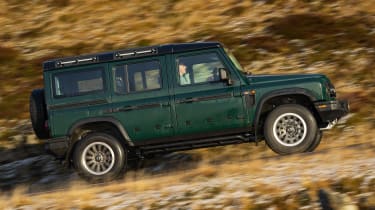Ineos Grenadier review: the Defender we never asked for
After 1000 miles in the Ineos Grenadier, we’ve been reminded why the Land Rover Defender needed to evolve
This is hard work. It’s dark, the roads are wet and I’m hacking away at the steering wheel, fully focused, my gaze locked onto the white lines. It’s been quite a while since I’ve driven something that requires this much mental capacity to drive in a straight line; it’s reminiscent of my 1972 Alfa Giulia before I replaced its worn steering box. The trouble is, the Ineos Grenadier wasn’t built 50 years ago: it’s a car designed and engineered for today, and one that costs an awful lot of money. From this first impression, it simply isn’t good enough.
The story of the Grenadier should be familiar by now. Conceived by Land Rover Defender enthusiast Sir Jim Ratcliffe, the founder of Ineos Group and one of the wealthiest figures in the UK, the Grenadier is what he believes the new-generation Defender could and should have been. Land Rover’s decision to move the nameplate upmarket and to a wider customer base certainly boosted its bottom line, but it left a breeze block-shaped hole in the rugged SUV sector that Ineos hopes to fill.
The trouble is, the maths don’t quite add up. There’s no easy way to say this: the Grenadier costs £76,000, with the barebones two-seat utility wagon version coming in at £64,500. So straight off the bat, this isn’t a farmyard workhorse – it’s a premium 4x4 that costs £10k more than the equivalent new Defender, and at that price, customers demand and expect more than just great off-road performance.
The Grenadier measures just under 4.9 metres long and around 2.1 metres wide (door mirrors included), and while it takes obvious inspiration from the old Defender, it’s more substantial somehow. The body panels are thicker and don’t have the characteristic rippling that plagued the Land Rover, there’s extensive underbody protection and the front bumper juts out like a spoilt child’s bottom lip. Kneel down and hanging below the body you can see the ladder frame chassis, which forms the foundation of the Grenadier’s technical makeup.
Ineos stresses that the Grenadier is, first and foremost, an off-road tool, and it’s been engineered as such from the ground up. As well as the ladder chassis – chosen for its toughness and modularity – there are solid beam axles front and rear, optional electronically actuated locking diffs and a recirculating-ball steering system. Ah yes, that. Commonly found on purpose-built utility vehicles, these generally transfer less kickback than a conventional rack, which is a particularly useful characteristic off-road. As we’ll discuss, on asphalt it’s another matter entirely.
There are also progressive-rate Eibach springs, Bilstein dampers, and Brembo brakes featuring two-piston front and single-piston rear calipers. BMW is also among the big-name parts suppliers, providing two 3-litre turbocharged straight-six engine options for the project – one diesel and the other petrol. We tested the latter, which generates 282bhp and 332lb ft of torque and drives through an eight-speed ZF gearbox and a two-speed transfer case.
Step inside the Grenadier and the Defender inspiration is less obvious, because that car’s ergonomic flaws have been replaced by new ones. The door panels are now wide enough to rest your arms, but the Recaro seats are tilted too far forwards to find a supportive driving position, and there’s an enormous wedge of a footrest that pitches your left leg at an awkward angle. It’s shaped this way because the exhaust runs beneath the driver’s side floor in UK cars.
Once you’re comfortable-ish, look ahead and you’ll notice a black display panel nestled into the dashboard behind the steering wheel. Oddly, that’s not the instrument pack but where the warning lights live – the speedo and rev counter occupy the right-hand third of the central 12.3-inch infotainment touchscreen, away from your sight line. The system is linked up to an iDrive-style rotary controller on the centre console, and while the information display eats into the available screen area, the interface is relatively easy to read.
Chances are you won’t be looking at the infotainment screen initially. It’s the bank of roof-mounted buttons and toggle switches that catch your eye first, flanked by optional pop-out sky windows in this test car. Novel? Yes. A pain to operate while on the move? Also yes, but thankfully the switches you’ll use most are mounted on the dash.
But besides the ergonomics, this doesn’t look or feel like a £76,000 interior. The switchgear doesn’t operate with the positive thunk you might expect and our test car had a few quality issues, namely a horribly clunky transfer-case lever that had us stuck in low range for a while, and temperamental door-lock buttons. The driver's door needed a full-force slam to close properly, too.
Nudge the BMW-sourced gear selector backwards into drive and the Grenadier slurs forwards. The inherent smoothness of the B58 straight-six is undermined slightly by resonances inside the cabin, which can sometimes make the Grenadier feel like an idling school bus, but the effortless torque delivery makes relatively light work of the 4x4’s enormous mass. The full 332lb ft is available from 1750rpm, and the torque-converter 'box shuffles slickly through the ratios to make the best use of the broad torque band.
Unfortunately, things go south from there. Even at parking speeds the steering feels disconcertingly indirect and slow, and having applied a few turns of lock you need to unwind it yourself – and fairly sharpish – as the self-centring effect is very weak. The enormous 13.5-metre turning circle doesn’t help matters, although visibility out of the boxy glasshouse is good.
The Grenadier was never going to be entirely at home in town, but the low-speed unwieldiness isn’t its only issue. If you’re used to driving a conventional modern SUV you’re in for a bit of a shock: just keeping the Grenadier in a straight line is a chore, and you need to concentrate to account for the slow, vague, lifeless steering response. This is made worse by the BFGoodrich all-terrain tyres Ineos fits to all its press cars, as there’s a tangible delay while the chunky tread blocks twist and bite against the road. Put simply, it's hard to relax.
Cruise up to motorway speeds and as that upright body begins to batter the air, the noise levels rise; not to unacceptable levels, but not a million miles away. It’s certainly more refined and sophisticated than the old Defender, and it does feel like Ineos has spent some time dialling in the live-axle suspension. The Grenadier gobbles up speed bumps with less shimmy and shudder than you might find in a similarly configured vehicle, and it does feel tough and relatively absorbent. Only gnarly roads – or those that work one side of the car harder than the other – start to jostle the car around heavily. Stopping quickly is more of an issue; the brakes lack outright power and the Grenadier can sometimes be dragged off course while slowing on bumpy surfaces.
In many ways, you need to drive the Grenadier like a classic car, leaving plenty of margin (even at sensible speeds) and working the controls much more than you would in a conventional SUV. You do learn to account for these peculiarities with time (we racked up nearly 1000 miles during our test), but jumping into a new Defender afterwards is nothing short of a revelation.
Ineos is happy to concede to the latest Land Rover for on-road dynamics though – in fact, that was essentially the plan from the start. Off-road ability, ease of repair and durability have been prioritised above all, and having driven an early pre-production Grenadier through a muddy quarry last year, we can vouch for its ability to plough through most of what you can throw at it.
It scampered through the sludge and took impacts in its stride, even though the locking front and rear diffs were inoperable on the prototype. Impressive wheel articulation and those live axles ensure that all four corners dig in to find traction, and the Grenadier only ran out of ideas on the very steepest slippery inclines. It even scaled those with a bit of extra commitment.
On the way down, switching to low range allows the Grenadier to creep in a controlled descent under engine braking alone, and the bodywork doesn't ground out when you meet flat land thanks to approach and departure angles of 35.5 and 36.1 degrees respectively. The heavy-duty componentry suggests that it could take this kind of abuse for some time.
Can it go further than a Defender? Our time in the Grenadier was confined to the road on this occasion, and it's hard to judge without testing the two side by side off-road. What we can say is that the much cheaper and exceedingly capable Land Rover proves that off-roaders needn't be so compromised and feel so archaic to drive, and this duality can be achieved through modern engineering. Some might argue that the Grenadier’s dynamic quirks are part of its charm, and that it’s no different in this regard to a Jeep Wrangler or indeed an old Defender. But it is different: it’s a brand new, clean-sheet vehicle that costs £76,000, and it already feels well out of date.









